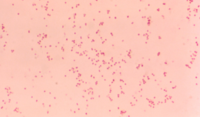
Photo from wikipedia
Acute otitis media (AOM) is the most common pediatric outpatient condition treated with antibiotics in the United States. Over 30% of children receive inappropriate antibiotics for AOM, contributing to increasing… Click to show full abstract
Acute otitis media (AOM) is the most common pediatric outpatient condition treated with antibiotics in the United States. Over 30% of children receive inappropriate antibiotics for AOM, contributing to increasing antimicrobial resistance and unnecessary adverse events. Strict adherence to diagnostic and treatment guidelines has been proposed by the American Academy of Pediatrics (AAP) Committee on Infectious Diseases as one strategy to combat inappropriate antibiotic use. Our objective was to describe adherence to the 2013 AAP guidelines on AOM. We performed a cross-sectional study on a random sample of visit notes for patients 3 to 59 months old diagnosed with otitis media based on ICD-10-CM codes (H65, H66, H67) and treated with antibiotics between 9/1/2017 and 8/31/2018 in an association of pediatric practices across Massachusetts. Children with tympanostomy tubes or a chronic medical condition increasing their risk for AOM were excluded. Based on the 2013 AAP diagnostic criteria, tympanic membrane exam descriptions were reviewed and classified as describing AOM or not. Antibiotic choices were classified as appropriate or inappropriate. Notes were then labeled as “fully adherent” (exam consistent with AOM and appropriate antibiotic choice), “partially adherent” (exam inconsistent with AOM or inappropriate antibiotic choice), and “non-adherent” (exam inconsistent with AOM and inappropriate antibiotic choice). Three hundred and ninety-four visit notes from 39 different practices were analyzed. One hundred and sixty-six notes (42%) were “fully adherent” to the AAP guidelines, 183 (46%) were “partially adherent” and 45 (11%) were “non-adherent” (Figure 1). In the “partially adherent” and “non-adherent” groups combined, exams were inappropriate in 179 notes (45.4%) and antibiotic choice was inappropriate in 94 notes (23.9%). Cefdinir was the most frequent inappropriate antibiotic (44/94, 46.8%) (Table 1). “Watchful waiting” occurred in only 7% (16/229) of eligible cases. Figure 1. Breakdown of encounters by adherence type Table 1. Cross-table of indicated and prescribed antibiotics Our analysis of independent pediatric practices showed moderate adherence to the AAP guidelines for AOM. Substantial room exists for improvement in diagnosing and treating AOM in young children, especially regarding the potential for watchful waiting. All Authors: No reported disclosures
Journal Title: Open Forum Infectious Diseases
Year Published: 2020
Link to full text (if available)
Share on Social Media: Sign Up to like & get
recommendations!